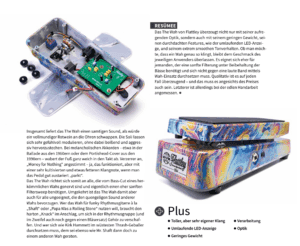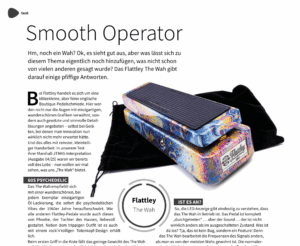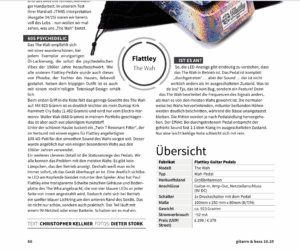Smooth Operator- The Flattley Oil Slick Wah Review Gitarre & Bass Magazine



http://Gitarre & Bass 10/2025 | GITARRE & BASS
Hm, another Wah? Okay, it looks good, but what else can be added on this topic that hasn’t already been said by many others? The Flattley The Wah offers some clever answers to that.
At Flattley, it’s a tiny but fine English boutique pedal forge. Here, not only are the eyes treated to unique, beautiful graphics, but also clever and meaningful detail solutions are offered – even for devices where one wouldn’t really expect innovation anymore. And all of this is done with the purest, meticulously crafted handwork. In our test of their Marshall JTM45 interpretation (issue 04/25), we were already full of praise – now let’s see what ‘The Wah’ has to offer.
The Wah comes with a beautiful, uniquely oil-painted finish, which instantly evokes the psychedelic vibes of the 1960s. Like all other Flattley pedals, this one was lovingly designed by Phoebe, the daughter of the house. In addition to its trippy outfit, it is also available with a rock’n’roll skull design. Upon first handling the box, the light weight of The Wah stands out. At 923 grams, it is significantly lighter than my Dunlop Kirk Hammett Cry Baby (1,482 grams) and is only surpassed in my portfolio by the Electro-Harmonix Wailer Wah (688 grams) – which is also made of flimsy plastic. Under the beautiful cover purrs a “Twin T Resonant Filter,” which, in conjunction with a specially made 100-kΩ pot for Flattley, is supposed to provide the smooth sound of the wah. This was supposedly only used by a few special wahs from the 1960s. Another clever detail is the status indicator of the pedal. We all know the problem with most wahs: there is no light indicating operation. Therefore, one doesn’t always know right away if the device is even on. A clearly visible LED at the head end can sometimes blind the player. So Paul Flattley has installed a transparent disc between the housing and the bottom plate of The Wah, which is illuminated from the inside by four blue LEDs on each side. As a result, a gentle blue light ring encircles the lower edge of the device when in operation. This is not only beautiful but also practical. The unit runs on a 9V power supply or a battery. Let’s turn it on.
IS IT ON? So, the LED display clearly indicates that the Wah is in operation. The pedal is fully pressed down… but the sound… it’s not really different than when it’s switched off. What’s going on? Well, this is not a bug, but a feature! Because the Wah processes the frequencies of the signal differently than what you are used to from most wah pedals. The normally pronounced, sometimes biting highs that appear in wahs are significantly cut, while the lows remain untouched. The mids are emphasized depending on the position of the pedal. The effect: When the pedal is fully pressed, the sound heard is almost 1:1 the same as the sound when it’s off. Only a slightly hoarse note sneaks in.
Overall, The Wah delivers a velvety sound, as if a full-bodied red wine were sloshing into the ears. The solos can be modulated with great emotion without being biting and aggressive. With melancholic chords – like in the ballad from the 1960s or the Portishead cover from the 1990s – the foot sways softly to the beat. With the overdrive on, ‘Money for Nothing’ tuned – yes, that works, but with a very cultivated and somewhat fatter sound note when the pedal is well balanced and ‘parked’. The Wah is thus aimed at all those who are annoyed by the bass cut of a conventional wah and actually need a gentler filtersweep. Conversely, The Wah is also unsuitable for anyone who prefers the whining sound of other wahs. Those who want to use the wah for funky rhythm guitar like ‘Shaft’ or ‘Papa Was a Rolling Stone’ need the hard ‘crack’ in the attack to make themselves heard in the rhythm section (and, if in doubt, against a brass arrangement as well). And for those who have to assert themselves like Kirk Hammett in the wildest thrash mayhem, it is also advisable to go for a different wah just like Mr. Shaft.
RESUME The Wah from Flattley not only impresses with its exciting appearance, but also with its light weight, well-thought-out features such as the continuous LED display, and its extremely smooth tonal behavior. Whether one wants a Wah to sound exactly like this is left to the taste of the individual user. It is more suitable for someone who needs a gentle filtering while retaining the bass and does not need to assert themselves against a loud band with the use of Wah. In terms of quality, it is definitely convincing – and considering the price, it should be. However, the latter is appropriate given the exquisite craftsmanship.
